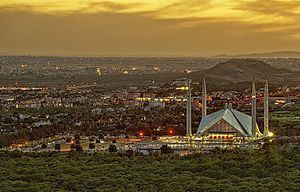Cities and Town's Pakistan Population 4.7 million (2015) | Time zone Pakistan Standard Time | |
 | ||
Principal cities Islamabad, Rawalpindi, Murree, Attock, Wah Cantt | ||
The Islamabad-Rawalpindi metropolitan area is Pakistan's third most populous metropolitan area. It consists principally of the twin cities of Islamabad and Rawalpindi, along with smaller towns such as Murree, Wah Cantonment, Taxila, and several gated suburbs including Bahria Town and DHA Islamabad.
Contents
Covering the Pothohar Plateau, the area consists of the ancient town of Taxila, which is a World Heritage Site; the colonial cities of Rawalpindi and Murree, and the modern planned city of Islamabad. The area received a major boom with the construction of Islamabad as the capital city of Pakistan in the 1960s.
Geography
Islamabad and Rawalpindi are located in the Potohar region of northern Punjab, against the backdrop of the Margalla Hills.
Economy
Islamabad is a net contributor to the Pakistani economy, as whilst having only 0.8% of the country's population, it contributes 1% to the country's GDP. Islamabad Stock Exchange, founded in 1989, is Pakistan's third largest stock exchange after Karachi Stock Exchange and Lahore Stock Exchange, and was merged to form Pakistan Stock Exchange. The exchange had 118 members with 104 corporate bodies and 18 individual members. The average daily turnover of the stock exchange is over 1 million shares.
As of 2012, Islamabad LTU (Large Tax Unit) was responsible for Rs 371 billion in tax revenue, which amounts to 20% of all the revenue collected by Federal Board of Revenue. Islamabad has seen an expansion in information and communications technology with the addition two Software Technology Parks, which house numerous national and foreign technological and information technology companies. The tech parks are located in Evacuee Trust Complex and Awami Markaz. Awami Markaz houses 36 IT companies while Evacuee Trust house 29 companies.
The economy of Rawalpindi and the surrounding district has a diverse industrial base, but remains mainly service based. According to the general survey of industry conducted by Directorate of Industries and Mineral Development Punjab, there are 939 industrial units operating in the district. This district is not famous for industrial goods like other districts. The progress has been mostly in the private sector. The existing industrial units provide employment to about 35,000 people, i.e., about 1.6% of district population is directly employed in large, medium and small industrial units. The Technical/Vocational Training Institute operating in the district turns out about 1,974 technicians/artisans annually. They are trained in engineering, air conditioning, drafting, metallurgy, welding, auto knitting, telecom and commerce, etc. Jinnah Road, formerly known as City Saddar Road, is one of the busiest business markets. It could be considered as business headquarters northern Pakistan including retailers, wholesalers, distributors, manufacturers having an approximately cash flow of more than 1 billion rupees per day. The importance of Jinnah Road can be seen by the presence of more than nine banks on the road with more opening soon.
Infrastructure
The metro area is connected by a network of highway's with the rest of the country. Within the metro area the Islamabad Highway and Kashmir Highway provide the primary link between Islamabad and Rawalpindi. The area is divided by the Grand Trunk Road which connect's the region with Lahore and Peshawar. The newer, M2 Motorway contact's the area with Lahore, and through Lahore with the port city of Karachi.
The area is also connected to the Pakistan Railway's national railway network. The area is served with the Benazir Bhutto International Airport (BBIA) which is the third-busiest airport in Pakistan, the under construction New Islamabad International Airport will replace the BBIA in 2017. The Rawalpindi-Islamabad Metrobus is a 24 km (14.9 mi) bus rapid transit system that serves the twin cities of Rawalpindi and Islamabad with the larger metropolitan area. It uses dedicated bus lanes for all of its route covering 24 bus stations.
Politics
As Pakistan's capital city, Islamabad serves as the seat of the federal government and is the country's political center. Rawalpindi has remained important historically, as it hosts the headquarters of Pakistan's powerful army. Rawalpindi also temporarily served as the federal capital when Islamabad was being built in the 1960s, to replace Karachi as the capital.
